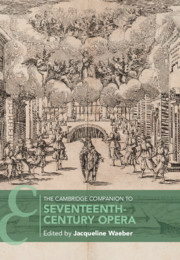Book contents
- The Cambridge Companion to Seventeenth-Century Opera
- Cambridge Companions to Music
- The Cambridge Companion to Seventeenth-Century Opera
- Copyright page
- Contents
- Music Examples
- Figures
- Tables
- Contributors
- Preface
- Chronology
- Abbreviations
- Part I The Italian Foundations
- Part II Society, Institutions, and Production
- 5 Opera for a Paying Public (Italy c. 1637–c. 1700)
- 6 ‘Una bella voce, un bel trillo, ed un bel passaggio’
- 7 Opera, Gender, and Voice
- 8 Dance and Ballet
- 9 Staging Opera in the Seventeenth Century
- Part III National Traditions (outside Italy)
- Further Reading
- Index
8 - Dance and Ballet
from Part II - Society, Institutions, and Production
Published online by Cambridge University Press: 08 December 2022
- The Cambridge Companion to Seventeenth-Century Opera
- Cambridge Companions to Music
- The Cambridge Companion to Seventeenth-Century Opera
- Copyright page
- Contents
- Music Examples
- Figures
- Tables
- Contributors
- Preface
- Chronology
- Abbreviations
- Part I The Italian Foundations
- Part II Society, Institutions, and Production
- 5 Opera for a Paying Public (Italy c. 1637–c. 1700)
- 6 ‘Una bella voce, un bel trillo, ed un bel passaggio’
- 7 Opera, Gender, and Voice
- 8 Dance and Ballet
- 9 Staging Opera in the Seventeenth Century
- Part III National Traditions (outside Italy)
- Further Reading
- Index
Summary
Dance and opera had a much closer relationship in the seventeenth century than most histories of opera convey. It is well known that for the French dance was a fundamental part of the work, integrated into every act, but even across the rest of Europe audiences almost always watched dancing as part of an evening spent at the opera. What audiences saw varied considerably according to genre, time, and place; even in important operatic centres much remains to be learned about the intersections of opera and dance. Nowhere is it possible to fully perceive how dance functioned across an entire work, but there are a surprising number of surviving choreographies for individual dances, all from either the beginning or the end of the century. Moreover, enough accounts of dancing exist, some of them in libretti, to show that both action dances and dancing based on abstract floor patterns co-existed throughout the period. By the end of the century the technique of dance was expressed via terminology in French – a vocabulary still used in classical ballet – but local traditions helped define national and even regional styles that impacted operatic practices.
- Type
- Chapter
- Information
- The Cambridge Companion to Seventeenth-Century Opera , pp. 170 - 189Publisher: Cambridge University PressPrint publication year: 2022
- 1
- Cited by

